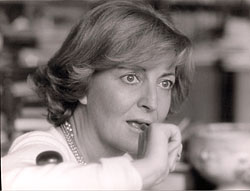Massimilla Baldo Ceolin
DOI: 10.1063/PT.3.1686
When Massimilla “Milla” Baldo Ceolin passed away in Padua, Italy, on 25 November 2011, high-energy particle physics lost a trailblazer.
Milla was born in Legnago, Italy, near Verona, on 12 August 1924. She grew up under Benito Mussolini’s government and has written that in her early years she was “faced with a world in disorder and disaster. . . . My family had to leave town and take refuge in the nearby countryside. . . . During these long days, I read many books of popular science.” Italy recovered slowly from World War II, and the relatively inexpensive photographic emulsions offered Italian scientists the possibility of keeping up with current cosmic-ray research, continuing a tradition that went back to Bruno Rossi at the beginning of the 1930s. Because of Allied bombing in northern Italy, Milla had to wait until the end of the war to begin her university studies. In 1952 she received her laurea from the University of Padua with a dissertation on pion nuclear capture under the supervision of Nicolò Dallaporta.
The decade of the 1950s was the golden age of the nuclear photographic emulsion method, when kaons and hyperons were being discovered in confusing numbers and their properties were being explored. Initially, the only sources of those new particles were cosmic-ray collisions, but by the mid 1950s, a new generation of accelerators was producing beams of particles with energies in the GeV range. Milla first worked on charged and neutral kaons with Jack Fry in Padua. Their close collaboration and friendship began with a systematic study of the problems of K0–
After the discovery of the proton and neutron antiparticles, Milla discussed with Derek Prowse at a 1957 conference the idea of extending that discovery to the realm of hyperons. After Prowse exposed nuclear emulsions to a pion beam, he and Milla detected the first antihyperon, the antilambda.
In the early 1960s, Milla began using bubble chambers at Argonne National Laboratory, CERN, and the Institute for Theoretical and Experimental Physics in Moscow to explore selection rules and conservation laws in the kaon system. After the discovery of neutral currents, she redirected her experimental program to neutrino physics. She worked with Helmut Faissner’s group at RWTH Aachen, where they used spark chambers to measure scattering cross sections of neutrinos off electrons.
In the mid 1970s, Milla was a member of a large international collaboration that used a liquid deuterium bubble chamber at CERN’s Super Proton Synchrotron to explore neutrino interactions with protons and neutrons. Her interest in neutrinos extended to solar neutrinos, which she studied as part of the collaboration working on the ICARUS detector in Italy’s Gran Sasso Laboratory.
In 1988 Milla started the Workshops on Neutrino Telescopes at the Venetian Institute for Sciences, Humanities, and Arts. In addition to her vigorous research career, Milla had a deep interest in Galileo Galilei, most appropriate for a physicist in Padua. She was delighted to combine celebrations of the 400th anniversary of Galileo’s telescopic discoveries with a neutrino workshop.
A special commemorative medallion showing Galileo presenting a telescope to the Doge was produced for the occasion. Its reverse carries an inscription in Italian of one of Milla’s favorite quotes by Galileo; its translation is “I deem it of more value to find out some truth about however light a matter than to engage in long disputes about the greatest questions without achieving any truth.” The motto of the Padua Institute of Physics, it was also used by Milla in her 2002 paper in the Annual Review of Nuclear and Particle Science (volume 52, page 1) on the nuclear emulsion era of the 1950s; each volume of the Annual Reviews starts with a historical review by a distinguished scientist.
A respected leader and enthusiastic and creative organizer at both the national and international levels, Milla was selected for administrative positions at the University of Padua, culminating in a five-year term as director of the physics department. Her experimental expertise and research were widely recognized, and she was honored many times. Of special note were the prestigious Antonio Feltrinelli Prize for Physics from the Lincean Academy in 1976 and the 1978 and 1993 Golden Medals from the Italian Ministry for Universities and Scientific and Technological Research.
In a sense, Milla was a real descendant of Galileo; for both, the scientific result must be sought through a careful analysis of the experimental data and driven by a creative vision.
In her long professional career, one particular event made her most proud: “A national competition for a full professorship in physics opened up. I competed and I won. And it was my own department that offered me the professorship at the University of Padova, where I became the first woman to obtain a chair since the University’s foundation in 1222.”

Massimilla Baldo Ceolin

More about the Authors
Luisa Bonolis. Association for Physics Teaching, Rome.
Michael Friedlander. Washington University in Saint Louis, Saint Louis, Missouri.




